J. Mater. Chem. A|Organic-inorganic hybrid Ti₃C₂ functionalized cellulose-based textiles as emerging wearable materials for bioprotection/thermal management/EMI
QQ Academic Group: 1092348845
Detailed
MXene is a two-dimensional star material that is even hotter than graphene. As an advanced MXene manufacturer, BeiKonami has launched special offers, 10% off mxene and other materials, and more preferential prices, waiting for you to kill!

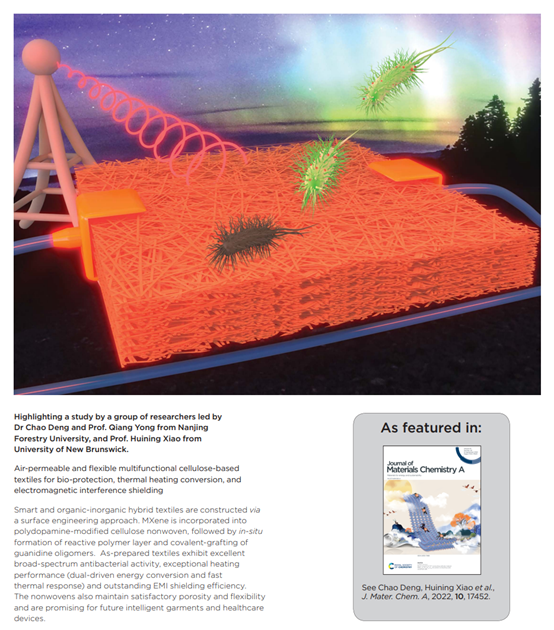
Research Background
In recent years, smart textile materials have attracted great research interest due to their flexibility, comfort, and multiple washability, as well as their potential applications in energy harvesting, storage and conversion, smart sensing, and human monitoring. Electronics with motion monitoring, human-computer interaction, electromagnetic interference (EMI) shielding, and healthcare are considered key contenders for next-generation wearable electronics. However, combining novel functionalities with the inherent comfort, permeability, and porosity of textile substrates remains a challenge. Currently, graphene, carbon nanotubes (CNTs), boron nitride, metal nanoparticles, conducting polymers, and other active nanostructured materials have been used to decorate polymers or bio-based textiles by various methods. Although incorporating nanostructured materials into textiles can render them electrothermally or photothermally active, mechanical deformation (such as cleaning, scratching, and/or bending) can cause the deposited functional materials to peel or crack, affecting the electrical conductivity of the fabrics and thermal conductivity, ultimately leading to various functions of wearable smart textiles that cannot be realized. In addition, the rapid growth of wearable electronics has exacerbated electromagnetic radiation pollution, posing a serious health risk.
To address these issues, we prepared cellulose-based wearable smart textiles for bioprotection, thermal management, and electromagnetic interference shielding by means of organic-inorganic hybridization. First, in order to provide more active sites for hydrogen bonding for MXene nanosheets, dopamine (DA) was in-situ polymerized on the surface of cellulose fibers, and the MXene layers were assembled on cellulose-based nonwovens by multiple dipping. surface. Subsequently, a polyglycidyl methacrylate (PGMA) layer was in-situ polymerized outside the MXene layer, which not only reduced the surface energy of MXene and increased the hydrophobicity of PDA/MXenes/PGMA cellulose textiles, but also protected MXene from oxidation , while providing epoxy groups for the covalent grafting of antibacterial materials. The prepared breathable, hydrophobic smart fabrics have excellent antibacterial properties as well as excellent electrothermal and photothermal response properties. Furthermore, smart textiles outperform other textile fiber-based shielding materials previously reported in terms of EMI shielding performance, which provides a new strategy for the preparation of multifunctional textiles for personal protection, thermal management, and healthcare.
Introduction
Recently, Dr. Deng Chao from Nanjing Forestry University and Prof. Huining Xiao from the University of New Brunswick, Canada, etc., have prepared organic-inorganic hybrids with excellent antibacterial activity, thermal management and electromagnetic interference (EMI) through layer-by-layer assembly of organic-inorganic hybrids. ) multifunctional cellulose-based textiles with shielding properties. Modification of highly conductive MXene on polydopamine (PDA)-modified cellulose-based nonwovens, followed by in-situ polymerization of glycidyl methacrylate (GMA), the resulting PGMA layer is not only conducive to the covalent bonding of antibacterial materials. branches and protects MXene from oxidation. The smart textile has excellent antibacterial properties (the antibacterial efficiency of the material against E. coli and S. aureus is greater than 99.99%), excellent heating performance (dual driving energy conversion, fast thermal response), and excellent EMI shielding efficiency, while at the same time The porosity and flexibility of the non-woven fabric are still maintained. This versatile wearable textile has promising applications in bioprotection, thermal management, and EMI shielding, making it ideal for future smart clothing and healthcare products.
This work was selected as a back cover article and published in the top international journal Journal of Materials Chemistry A (impact factor 14.511) with the title: Air-permeable and flexible multifunctional cellulose-based textiles for bio-protection, thermal heating conversion, and electromagnetic interference shielding .
Doctoral students Yu Zhaochuan and Dr. Deng Chao are the first authors of this article.
Graphical guide
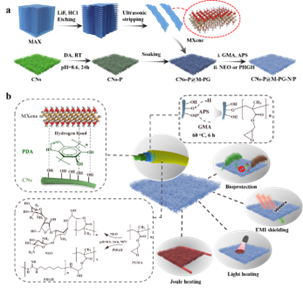
Figure 1. Schematic diagram of the preparation and application of CNs-P@M-PG-NEO/PHGH materials.
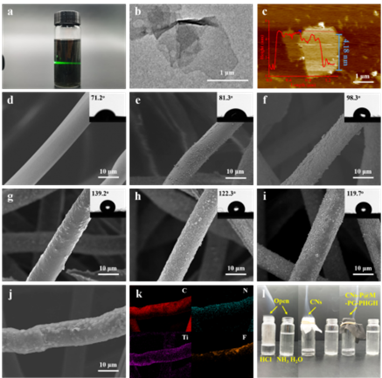
Figure 2. Morphological characterization. (a) Tyndall effect of MXene(Ti3C2Tx) aqueous dispersions. (b) TEM and (c) AFM images of MXene nanosheets. (d) CNs, (e) CNs-P, (f) CNs-P@M, (g) CNs-P@M-PG, (h) CNs-P@M-PG-NEO, (i) CNs- SEM image of P@MPG-PHGH. (j) Morphology and corresponding (k) EDS image of a single fiber of CNs-P@M-PG-PHGH material. (l) Optical images of 2 glass vials containing HCl and NH4OH covered with CNs and CNs-P@M-PG-PHGH, respectively. The insets in d-i are the corresponding WCA optical photos, respectively.
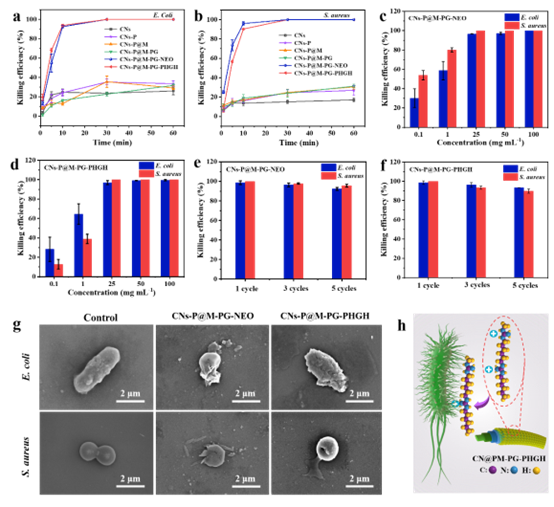
Figure 3. Antibacterial properties. CNs, CNs-P, CNs-P@M, CNs-P@M-PG, CNs-P@M-PG-NEO and CNs-P@M-PG-PHGH pairs (a)E at different contact times. Antibacterial efficiency of coli and (b) S. aureus. (c) Antibacterial efficiency of CNs-P@M-PG-NEO and (d) CNs-P@M-PG-PHGH at different concentrations (the mass concentrations of NEO/PHGH in the reaction solution were 0.1, 1, 25, 50, 100 mg mL-1). (e) Antibacterial efficiency of CNs-P@M-PG-NEO and (f) CNs-P@M-PG-PHGH (50 mg mL-1) against E. coli and S. aureus after multiple washes. (g) SEM images of E. coli and S. aureus before and after CNs-P@M-PG-NEO and CNs-P@M-PG-PHGH treatments. (h) Antibacterial mechanism of CNs-P@M-PG-PHGH.
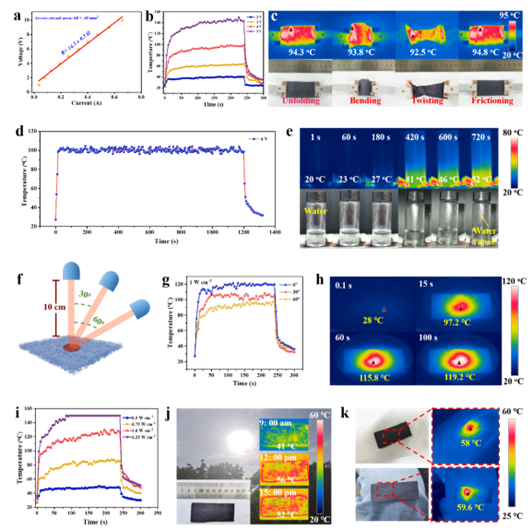
Figure 4. Electrothermal and photothermal properties of Ns-P@M-PG-PHGH material. (a) I-V curves of CNs-P@M-PG-PHGH. (b) Electric heating curves of CNs-P@M-PG-PHGH (MXene content: 1.5 mg cm-2) as a function of time at different voltages. (c) Infrared and optical images of CNs-P@M-PG-PHGH in different deformation states (input voltage: 4 V). (d) Electrothermal stability of CNs-P@M-PG-PHGH within 1200 s (input voltage: 4 V). (e) Infrared and optical images of electrically heated water at different times. (f) Schematic illustration of CNs-P@M-PG-PHGH irradiated with a simulated visible light source (filter: 350-780 nm). (g) Time-dependent temperature curves of CNs-P@M-PG-PHGH under different angle light sources (0°, 30° and 60°). (h) Infrared images of CNs-P@M-PG-PHGH after vertical (0°) illumination with simulated light source (1.0 W cm-2) at different time intervals. (i) Temperature curves of CNs-P@M-PG-PHGH with increasing power density (0.50-1.25 W cm-2). (j) Infrared images of CNs-P@M-PG-PHGH illuminated by sunlight at different times (April 23, Nanjing, China). (k) Optical and infrared images of CNs-P@M-PG-PHGH-coated arms and knees illuminated with a simulated light source (0.75 W cm-2).

Figure 5. EMI shielding performance of CNs-P@M-PG-PHGH material. (a) SET, (b) SER, and (c) SEA of CNs-P@M-PG-PHGH with different MXene loadings at frequencies from 8.2 to 12.4 GHz (X-band). (d) Average SER, SEA, and SET of CNs-P@M-PG-PHGH with different MXene loadings at frequencies from 8.2 to 12.4 GHz. (e) SEA to SET ratio of CNs-P@M-PG-PHGH. (f) Power coefficients of CNs-P@M-PG-PHGH with different MXene loadings. (g) EMI shielding mechanism of CNs-P@M-PG-PHGH. (h) Comparison of EMI shielding effectiveness per unit coating thickness (SET/t) of CNs-P@M-PG-PHGH with other EMI shielding coated fabrics reported in the literature.
Summarize
The in-situ polymerized PDA layer on the surface of the cellulose-based nonwoven can firmly fix the MXene nanosheets on the fiber surface through hydrogen bonds, and the formed MXene conductive network is covalently linked to the PHGH/NEO antibacterial material through the PGMA layer. Tunable electrical conductivity and antibacterial efficiency, as well as preserved fabric flexibility and porous properties, endow smart textiles with excellent antibacterial activity, superior heating performance and EMI shielding efficiency, making them useful in bioprotection, personal thermal management, and smart healthcare and other fields have broad application prospects
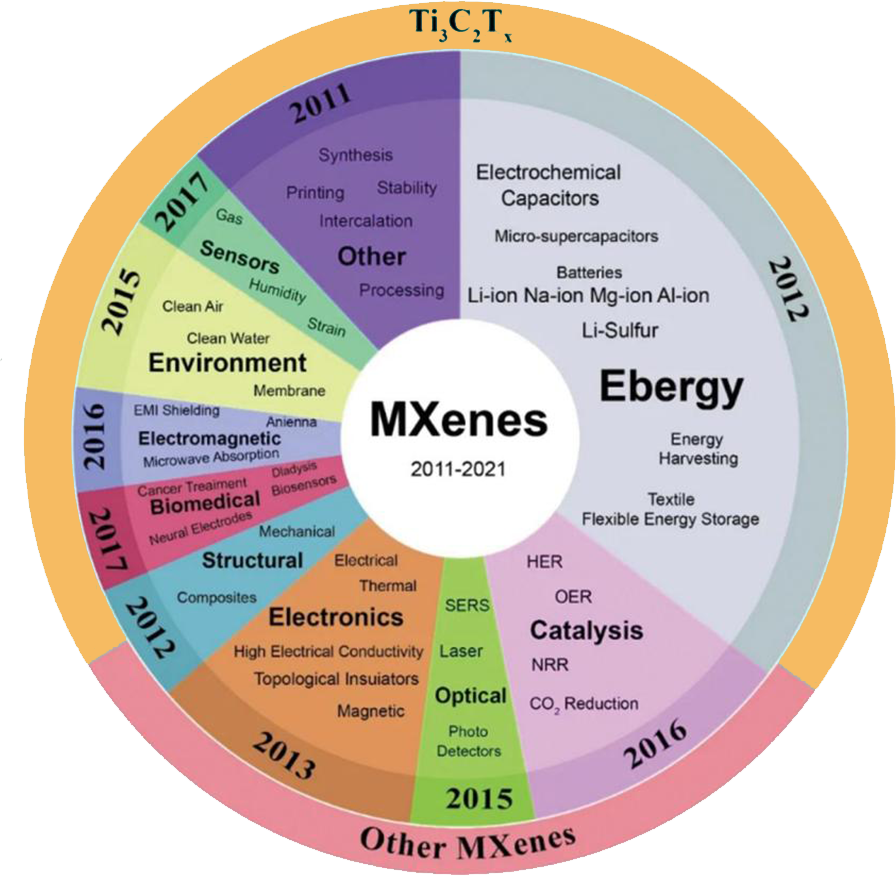



Research Background
In recent years, smart textile materials have attracted great research interest due to their flexibility, comfort, and multiple washability, as well as their potential applications in energy harvesting, storage and conversion, smart sensing, and human monitoring. Electronics with motion monitoring, human-computer interaction, electromagnetic interference (EMI) shielding, and healthcare are considered key contenders for next-generation wearable electronics. However, combining novel functionalities with the inherent comfort, permeability, and porosity of textile substrates remains a challenge. Currently, graphene, carbon nanotubes (CNTs), boron nitride, metal nanoparticles, conducting polymers, and other active nanostructured materials have been used to decorate polymers or bio-based textiles by various methods. Although incorporating nanostructured materials into textiles can render them electrothermally or photothermally active, mechanical deformation (such as cleaning, scratching, and/or bending) can cause the deposited functional materials to peel or crack, affecting the electrical conductivity of the fabrics and thermal conductivity, ultimately leading to various functions of wearable smart textiles that cannot be realized. In addition, the rapid growth of wearable electronics has exacerbated electromagnetic radiation pollution, posing a serious health risk.
To address these issues, we prepared cellulose-based wearable smart textiles for bioprotection, thermal management, and electromagnetic interference shielding by means of organic-inorganic hybridization. First, in order to provide more active sites for hydrogen bonding for MXene nanosheets, dopamine (DA) was in-situ polymerized on the surface of cellulose fibers, and the MXene layers were assembled on cellulose-based nonwovens by multiple dipping. surface. Subsequently, a polyglycidyl methacrylate (PGMA) layer was in-situ polymerized outside the MXene layer, which not only reduced the surface energy of MXene and increased the hydrophobicity of PDA/MXenes/PGMA cellulose textiles, but also protected MXene from oxidation , while providing epoxy groups for the covalent grafting of antibacterial materials. The prepared breathable, hydrophobic smart fabrics have excellent antibacterial properties as well as excellent electrothermal and photothermal response properties. Furthermore, smart textiles outperform other textile fiber-based shielding materials previously reported in terms of EMI shielding performance, which provides a new strategy for the preparation of multifunctional textiles for personal protection, thermal management, and healthcare.
Introduction
Recently, Dr. Deng Chao from Nanjing Forestry University and Prof. Huining Xiao from the University of New Brunswick, Canada, etc., have prepared organic-inorganic hybrids with excellent antibacterial activity, thermal management and electromagnetic interference (EMI) through layer-by-layer assembly of organic-inorganic hybrids. ) multifunctional cellulose-based textiles with shielding properties. Modification of highly conductive MXene on polydopamine (PDA)-modified cellulose-based nonwovens, followed by in-situ polymerization of glycidyl methacrylate (GMA), the resulting PGMA layer is not only conducive to the covalent bonding of antibacterial materials. branches and protects MXene from oxidation. The smart textile has excellent antibacterial properties (the antibacterial efficiency of the material against E. coli and S. aureus is greater than 99.99%), excellent heating performance (dual driving energy conversion, fast thermal response), and excellent EMI shielding efficiency, while at the same time The porosity and flexibility of the non-woven fabric are still maintained. This versatile wearable textile has promising applications in bioprotection, thermal management, and EMI shielding, making it ideal for future smart clothing and healthcare products.
This work was selected as a back cover article and published in the top international journal Journal of Materials Chemistry A (impact factor 14.511) with the title: Air-permeable and flexible multifunctional cellulose-based textiles for bio-protection, thermal heating conversion, and electromagnetic interference shielding .
Doctoral students Yu Zhaochuan and Dr. Deng Chao are the first authors of this article.
Graphical guide

Figure 1. Schematic diagram of the preparation and application of CNs-P@M-PG-NEO/PHGH materials.

Figure 2. Morphological characterization. (a) Tyndall effect of MXene(Ti3C2Tx) aqueous dispersions. (b) TEM and (c) AFM images of MXene nanosheets. (d) CNs, (e) CNs-P, (f) CNs-P@M, (g) CNs-P@M-PG, (h) CNs-P@M-PG-NEO, (i) CNs- SEM image of P@MPG-PHGH. (j) Morphology and corresponding (k) EDS image of a single fiber of CNs-P@M-PG-PHGH material. (l) Optical images of 2 glass vials containing HCl and NH4OH covered with CNs and CNs-P@M-PG-PHGH, respectively. The insets in d-i are the corresponding WCA optical photos, respectively.

Figure 3. Antibacterial properties. CNs, CNs-P, CNs-P@M, CNs-P@M-PG, CNs-P@M-PG-NEO and CNs-P@M-PG-PHGH pairs (a)E at different contact times. Antibacterial efficiency of coli and (b) S. aureus. (c) Antibacterial efficiency of CNs-P@M-PG-NEO and (d) CNs-P@M-PG-PHGH at different concentrations (the mass concentrations of NEO/PHGH in the reaction solution were 0.1, 1, 25, 50, 100 mg mL-1). (e) Antibacterial efficiency of CNs-P@M-PG-NEO and (f) CNs-P@M-PG-PHGH (50 mg mL-1) against E. coli and S. aureus after multiple washes. (g) SEM images of E. coli and S. aureus before and after CNs-P@M-PG-NEO and CNs-P@M-PG-PHGH treatments. (h) Antibacterial mechanism of CNs-P@M-PG-PHGH.

Figure 4. Electrothermal and photothermal properties of Ns-P@M-PG-PHGH material. (a) I-V curves of CNs-P@M-PG-PHGH. (b) Electric heating curves of CNs-P@M-PG-PHGH (MXene content: 1.5 mg cm-2) as a function of time at different voltages. (c) Infrared and optical images of CNs-P@M-PG-PHGH in different deformation states (input voltage: 4 V). (d) Electrothermal stability of CNs-P@M-PG-PHGH within 1200 s (input voltage: 4 V). (e) Infrared and optical images of electrically heated water at different times. (f) Schematic illustration of CNs-P@M-PG-PHGH irradiated with a simulated visible light source (filter: 350-780 nm). (g) Time-dependent temperature curves of CNs-P@M-PG-PHGH under different angle light sources (0°, 30° and 60°). (h) Infrared images of CNs-P@M-PG-PHGH after vertical (0°) illumination with simulated light source (1.0 W cm-2) at different time intervals. (i) Temperature curves of CNs-P@M-PG-PHGH with increasing power density (0.50-1.25 W cm-2). (j) Infrared images of CNs-P@M-PG-PHGH illuminated by sunlight at different times (April 23, Nanjing, China). (k) Optical and infrared images of CNs-P@M-PG-PHGH-coated arms and knees illuminated with a simulated light source (0.75 W cm-2).

Figure 5. EMI shielding performance of CNs-P@M-PG-PHGH material. (a) SET, (b) SER, and (c) SEA of CNs-P@M-PG-PHGH with different MXene loadings at frequencies from 8.2 to 12.4 GHz (X-band). (d) Average SER, SEA, and SET of CNs-P@M-PG-PHGH with different MXene loadings at frequencies from 8.2 to 12.4 GHz. (e) SEA to SET ratio of CNs-P@M-PG-PHGH. (f) Power coefficients of CNs-P@M-PG-PHGH with different MXene loadings. (g) EMI shielding mechanism of CNs-P@M-PG-PHGH. (h) Comparison of EMI shielding effectiveness per unit coating thickness (SET/t) of CNs-P@M-PG-PHGH with other EMI shielding coated fabrics reported in the literature.
Summarize
The in-situ polymerized PDA layer on the surface of the cellulose-based nonwoven can firmly fix the MXene nanosheets on the fiber surface through hydrogen bonds, and the formed MXene conductive network is covalently linked to the PHGH/NEO antibacterial material through the PGMA layer. Tunable electrical conductivity and antibacterial efficiency, as well as preserved fabric flexibility and porous properties, endow smart textiles with excellent antibacterial activity, superior heating performance and EMI shielding efficiency, making them useful in bioprotection, personal thermal management, and smart healthcare and other fields have broad application prospects


- Previous: AFM: In situ formation
- Next: MXene breakthrough: Na


 mxene academic
mxene academic